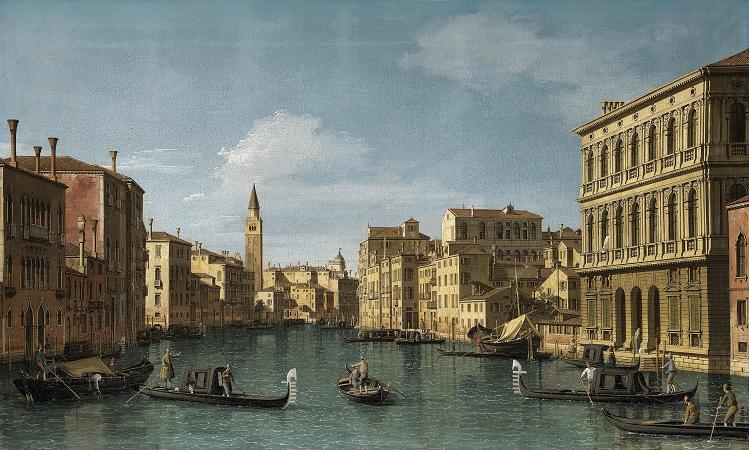Grand Canal, Venice (c1200). The Grand Canal is a channel in Venice, Italy. It forms one of the major water-traffic corridors in the city. One end of the canal leads into the lagoon near the Santa Lucia railway station and the other end leads into the basin at San Marco; in between, it makes a large reverse-S shape through the central districts of Venice. It is 3.8 km long, and 30 to 90 m wide, with an average depth of 5 metres. The banks of the Grand Canal are lined with more than 170 buildings, most of which date from the 13th to the 18th century, and demonstrate the welfare and art created by the Republic of Venice. The noble Venetian families faced huge expenses to show off their richness in suitable palazzos; this contest reveals the citizens' pride and the deep bond with the lagoon. Amongst the many are the Palazzi Barbaro, Ca' Rezzonico, Ca' d'Oro, Palazzo Dario, Ca' Foscari, Palazzo Barbarigo and to Palazzo Venier dei Leoni, housing the Peggy Guggenheim Collection. The churches along the canal include the basilica of Santa Maria della Salute. Centuries-old traditions, such as the Historical Regatta, are perpetuated every year along the Canal. Because most of the city's traffic goes along the Canal rather than across it, only one bridge crossed the canal until the 19th century, the Rialto Bridge. There are currently three more bridges, the Ponte degli Scalzi, the Ponte dell'Accademia, and the controversial Ponte della Costituzione from 2008, designed by Santiago Calatrava, connecting the train station to Piazzale Roma, one of the few places in Venice where buses and cars can enter. As was usual in the past, people can still take a ferry ride across the canal at several points by standing up on the deck of a simple gondola called a traghetto, although this service is less common than even a decade ago. Most of the palaces emerge from water without pavement. Consequently, one can only tour past the fronts of the buildings on the grand canal by boat. The Grand Canal probably follows the course of an ancient river flowing into the lagoon. Adriatic Veneti groups already lived beside the formerly-named Rio Businiacus before the Roman age. They lived in stilt houses and relied on fishing and commerce. Under the rule of the Roman empire and later of the Byzantine empire the lagoon became populated and important, and in the early 9th century the doge moved his seat from Malamocco to the safer Rivoaltus. Increasing trade followed the doge and found in the deep Grand Canal a safe and ship accessible canal-port. Drainage reveals that the city became more compact over time: at that time the Canal was wider and flowed between small, tide-subjected islands connected by wooden bridges. Along the Canal, the number of fondaco houses increased, buildings combining the warehouse and the merchant's residence. A portico covers the bank and facilitates the ships' unloading. From the portico a corridor flanked by storerooms reaches a posterior courtyard. Similarly, on the first floor a loggia as large as the portico illuminates the hall into which open the merchant's rooms. The facade is thereby divided into an airy central part and two more solid sides. A low mezzanine with offices divides the two floors. The fondaco house often had lateral defensive towers, as in the Fondaco dei Turchi. With the German warehouse, the Fondaco dei Tedeschi, it reflects the high number of foreign merchants working in Venice, where the republic supplied them with storerooms and lodging and simultaneously controlled their trading activity. More public buildings were built along the Canal at Rialto: palaces for commercial and financial Benches and a mint. In 1181 Nicolo Barattieri constructed a pontoon bridge connecting Rialto to Mercerie area, which was later replaced by a wooden bridge with shops on it. Warehouses for flour and salt were more peripheral. From the Byzantine empire, goods arrived together with sculptures, friezes, columns and capitals to decorate the fondaco houses of patrician families. The Byzantine art merged with previous elements resulting in a Venetian-Byzantine style; in architecture, it was characterized by large loggias with round or elongated arches and by polychrome marbles abundance. Along the Grand Canal, these elements are well preserved in Ca' Farsetti, Ca' Loredan and Ca' da Mosto, all dating back to the 12th or 13th century. During this period Rialto had an intense building development, determining the conformation of the Canal and surrounding areas.
more...













